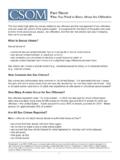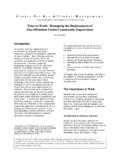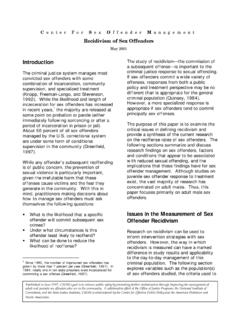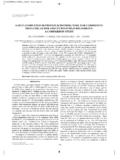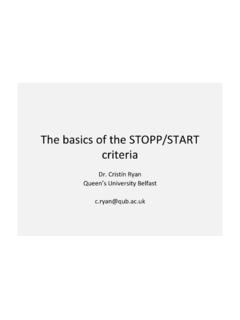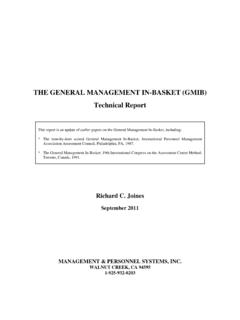Transcription of Juvenile Sex Offender Assessment Protocol-II (J …
1 Juvenile Sex Offender Assessment Protocol-II (J-SOAP-II) Manual Robert Prentky, Sue Righthand, 2003 NCJ 202316 Printed copies of this manual are available from the Office of Juvenile Justice and Delinquency Prevention s Juvenile Justice Clearinghouse. To order, call 800 851 3420 and ask for NCJ 202316. Contact Information The J-SOAP-II is an experimental scale and is the subject of ongoing research to improve reliability and further enhance predictive validity. We appreciate feedback from users about areas of ambiguity and ways to increase clarity. We are available to answer questions concerning the use of the J-SOAP, updates on validity studies, and training opportunities. Robert Prentky, Box 162 Accord, MA 02018-0162 Office: (508) 697 2744 Email: Sue Righthand, Box 1047 Rockland, ME 04841 VM: (207) 594 7880 Email: i Table of Contents Contact Information .. i 1 Caveat .. 1 Development and Validation of 2 2 Validation .. 2 J-SOAP-II.
2 5 References .. 6 Frequently Asked Questions .. 8 Scoring 11 Scoring Instructions .. 12 Section I. Static Risk Scale 1. Sexual Drive/Preoccupation Items .. 12 Scale 2. Impulsive/Antisocial Behavior Items .. 16 Section II. Dynamic Risk 21 Scale 3. Intervention 21 Scale 4. Community Stability/Adjustment 25 Juvenile Sex Offender Assessment Protocol-II Scoring Form .. 28 Juvenile Sex Offender Assessment Protocol-II Summary Form .. 29 ii Introduction The Juvenile Sex Offender Assessment Protocol-II (J-SOAP-II) is a checklist whose purpose is to aid in the systematic review of risk factors that have been identified in the professional literature as being associated with sexual and criminal offending. It is designed to be used with boys in the age range of 12 to 18 who have been adjudicated for sexual offenses, as well as nonadjudicated youths with a history of sexually coercive behavior. Decisions about reoffense risk should not be based exclusively on the results from J-SOAP-II.
3 J-SOAP-II should always be used as part of a comprehensive risk Assessment . Like any scale that is intended to assess risk, J-SOAP-II requires ongoing validation and possible revision, as we learn more about how J-SOAP-II works and about how best to assess the risk of youths who have sexually offended. Because the revised J-SOAP is a new scale, and we are just beginning to collect predictive validity data on it, we cannot provide users with cut-off scores for categories of risk at this point; this is all the more reason why scores from J-SOAP-II should not be used in isolation when assessing risk. Caveat When assessing risk with sex offenders in general, and with juveniles in particular, the stakes are often very high. In assessing the risk posed by a Juvenile , we have an enormous burden of responsibility. Decisions based on our evaluations can have a profound impact: on the one hand, protecting society from genuinely high-risk youths, while on the other hand, possibly resulting in severe, life-altering consequences for low-risk youths.
4 It is imperative that clinicians who assess the risk of adolescent offending be very knowledgeable of the challenges involved in assessing this population. Unlike adults, adolescents are still very much in flux. No aspect of their development, including their cognitive development, is fixed or stable. In addition, their life circumstances often are very unstable. In a very real sense, we are trying to assess the risk of moving targets. Since risk status may change, sometimes dramatically, in a brief period of time, we strongly recommend that youths be re-assessed for risk at a minimum of every 6 months. At the very least, Scales 3 and 4 should be rescored every 6 months. Re-assessments should be done even more frequently if the examiner is aware of risk-relevant changes that have occurred in the youth s life. Prior to using J-SOAP-II, users should have training and experience in assessing juveniles who commit sexual offenses and risk Assessment in general, particularly as it pertains to Juvenile sex offending.
5 In addition, prior to using J-SOAP-II, users should read the manual and be familiar with its contents. Before using the scale in any professional capacity, users should complete several practice cases and compare their scores with others who have scored the same case to identify and resolve any scoring difficulties. It is also recommended that J-SOAP-II users periodically consult with each other about their scoring and stay current with the evolving literature relevant for assessing juveniles who sexually offend. 1 Development and Validation of J-SOAP-II Development The original version of this risk Assessment scale for Juvenile sex offenders was developed at Joseph J. Peters Institute (JJPI) in Philadelphia in 1994 (Prentky, Harris, Frizzell, & Righthand, 2000). The risk Assessment variables were developed after reviews of the literature that covered five areas: (1) clinical studies of Juvenile sex offenders, (2) risk Assessment /outcome studies of Juvenile sex offenders, (3) risk Assessment /outcome studies of adult sex offenders, (4) risk Assessment /outcome studies from the general Juvenile delinquency literature , and (5) risk Assessment studies on mixed populations of adult offenders.
6 In all, 23 items representing 4 subscales were developed. These scales were intended to capture the two major historical (static) domains that are of importance for risk Assessment with this population (Scale 1: Sexual Drive/Sexual Preoccupation and Scale 2: Impulsive, Antisocial Behavior), and the two major dynamic areas that could potentially reflect behavior change (Scale 3: Clinical/Treatment and Scale 4: Community Adjustment). The latter two subscales were of particular importance, because the original risk Assessment protocol was developed to assess not only risk at discharge but change as a function of treatment. No a priori item weighting was used. All items were trichotomized and assumed, for lack of empirical data to suggest otherwise, to be of equal importance. Trichotomization was intended to be a compromise, adding some increase in sensitivity over a simple rating of present/absent, while at the same time preserving acceptable interrater reliability. The coding for each item provided, to whatever extent possible, behavioral anchors to increase clarity and reliability.
7 Validation The construction/validation sample consisted of 96 Juvenile sexual offenders, ranging in age from 9 to 20 (average age was 14), who were referred to JJPI for Assessment and treatment. The risk Assessment protocol was completed on all 96 Juvenile sex offenders as part of a comprehensive intake battery at JJPI. The protocol was completed again at time of discharge, on average 24 months later. The protocol was coded independently by two clinicians entirely from archival documents and data obtained from the intake battery. After the ratings were completed, the clinicians discussed disagreements, and the agreed-upon ratings were used to examine outcome. Twelve-month follow-up data were obtained on 75 of the 96 youths in the study. The short-term [12-month] recidivism rate of 11% included three youths that committed another sexual offense, four youths that committed a nonsexual victim-involved offense, and one youth who committed a nonsexual, victimless offense.
8 The inter-rater reliability (IRR) for all items, except for Caregiver Instability, was good to excellent, ranging from .75 to .91, with an average IRR of .83. The reliability for Caregiver Instability was poor (.59), and that item has since been revised. Three of the subscales had moderate internal consistency, with alphas ranging from .68 to .73. The Clinical/Treatment scale had a high degree of 2 internal consistency (.85). Three of the four subscales comprised items with high item-total correlations (r > .30). Seven of the 9 items in Scale 2, 4 of the 5 items in Scale 3, and all items in Scale 4 exceeded this benchmark. The exception was Scale 1. The only Scale 1 item with a reasonably high item-total correlation was Prior Charged Sex Offenses. Overall, there was an average total scale score of 21 for those juveniles who did not reoffend and an average scale score of 30 for those 3 juveniles who committed another sexual offense. These results were based on a very small sample of eight recidivists, only three of whom were sexual recidivists.
9 For that reason we applied no inferential statistics, and observed group differences were not confirmed by statistical significance. We looked at Treatment Outcome (assessed at time of discharge) in two ways, by correlating the total score for the six treatment outcome variables with the four follow-up variables and with the four subscales. The correlation between Treatment Outcome and the total scale score was .58. The correlations between Treatment Outcome and the two dynamic subscales were .62 for Clinical/ Treatment and .43 for Community Adjustment. The correlations between Treatment Outcome and Follow-Up were .35 for the juveniles who reoffended and .55 for the juveniles who were removed from the community and placed. This study was informative in pointing to areas that required revision and clarification. The scoring criteria for every item were carefully examined for ambiguity and behavioral examples and anchors were added. Two changes were made to Scale 1.
10 First, the Scale 1 item that included offense planning (History of Predatory Behavior) was replaced with a more clearly defined Offense Planning item. The new Offense Planning item was behaviorally anchored and easier to code from file data than the more inferential History of Predatory Behavior item that required difficult judgments about behaviors such as grooming and exploitation. Second, a fifth variable was added to Scale 1 that was intended to capture the degree to which the Juvenile sexualized his victims (for example, use of pornography in the offense, filming the victim, engaging in unusual or ritualized sexual acts with the victim). Two changes were also made to Scale 2. A Juvenile Antisocial Behavior item was added that was intended to assess general delinquency, and a History of Expressed Anger item was added that was designed to assess disruptions due to poorly controlled and poorly managed anger. The revised scale, completed in 1998 and referred to as J-SOAP, was examined with a sample of 153 juveniles in Maine (Righthand, Prentky, Hecker, Carpenter, & Nangle, 2000).
